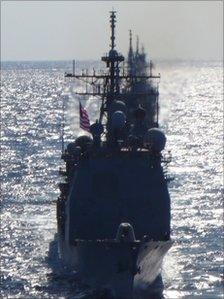Strength and power in seas off Japan
- Published
Warships from America and Japan complete their biggest ever joint exercises as tensions remain high in East Asia.
America and Japan have been holding their largest ever joint exercises off the coast of Okinawa, and the BBC's Alastair Leithead was on board the USS George Washington to observe.
There is a real thrill to landing aboard an American aircraft carrier while it is at sea - the adrenalin starts to pump as the plane makes small adjustments on its final approach.
Then as the wheels touch down on the short runway, a hook under the aircraft catches a metal cable on board and the G-force hits as the plane judders to a sudden halt.
Once your eyes adjust to the bright sunlight on deck, the sight of two dozen grey warships all moving together into a tight battle formation is a formidable sight.
But then presenting this picture is the idea of military war games, and the value of flying journalists out to record and describe the awesome power of the US military on display in China's backyard.
'Vital interests'
Every year, the US and Japan hold a week-long exercise known as "Keen Sword", but this year was the biggest yet.
It followed straight on from the US having similar training with South Korea, and after six months of the USS George Washington and its fleet criss-crossing East Asia for war games with Thailand and the Philippines, with even a stop in Vietnam.
The US is increasing its diplomatic overtures in Asia as China grows richer and more influential across the region.
But these joint exercises with Asian allies are also a show of strength, sending a signal that the US still has a lot of sway, not to mention firepower, in this region.

Competition in the seas of the East Asian region is increasing
Just over the horizon from the war games are a group of islands held by Japan, but claimed by both China and Taiwan.
It was here in September that a collision between the Japanese coastguard and a Chinese fishing trawler, whose captain was arrested, led to a serious diplomatic incident.
There was concern when Beijing described much of the South China Sea as a "core concern", with claims of sovereignty over other disputed islands despite protests by the neighbours.
The islands have untapped offshore oil and gas reserves, and these waters are a vital trade route for goods being shipped around the world.
"We have national interests here and I would offer even vital interests," said Rear Admiral Dan Cloyd, the US Strike Group Commander.
"Freedom of movement, free trade, the ability to grow and prosper and I think stability here is exceedingly important for the future, not just for nations in this part of the world but the whole planet," he said.
'Great confidence'
China's military spending is growing, its historical desire for Taiwan continues and its impassive approach to North Korea has ramped up tensions with the US this year.
Some analysts are increasingly worried it could lead to conflict, but that is not the view of Yan Xuetong, executive director of the Institute of International Studies at Tsinghua University in Beijing.

The exercises are a show of US military might in the East Asian region
"I think there is serious competition between China and the US, but there is no danger of military clashes between the two countries," he said.
He argues having two strong countries in competition in Asia is more likely to promote mutual respect and maintain peace and stability rather than reduce it.
"Look at the situation between the US and the Soviet Union during the Cold War - no matter what happened the two troops never shot at each other, so I have great confidence in the relationship between China and the US."
He also argues China is doing nothing wrong - its economy is growing and it is increasing its military accordingly - it is perhaps other countries' reaction which is sparking trouble.
China's own aircraft carriers are on order, if some years away, but it also has a significant missile presence along its coast and the tools to counter the vast US military.
In truth, China's economic growth is welcomed by its Asian neighbours as they gain from its wealth, but at the same time the perceived increase in aggression over things such as territorial disputes has made nearby countries nervous.
It suits them to hedge their bets, working more and more with the growing regional power, while at the same time maintaining a strong relationship with the US - given America's commitment to defence of key allies in the region.
The USS George Washington itself is like a floating city, with 5,500 men and women living on board, 60 aircraft and two nuclear reactors which could allow it to stay at sea for 25 years without coming ashore.
And the experience of being catapulted off the deck at full speed for the return flight to Okinawa was even more of an adrenalin, G-force-filled rush than the landing.
For a display of strength and power - with aircraft flyovers and breaching submarines - the point was made to the 20 or so mostly Japanese journalists.
But China is only growing stronger - this will be one of the most important regions of the world for diplomacy and peace-building in the century's second decade.
Warships from America and Japan complete their biggest ever joint exercises as tensions remain high in East Asia.
- Published3 December 2010
- Published1 December 2010
- Published1 December 2010
- Published29 November 2010
- Published25 November 2010
- Published25 July 2010